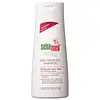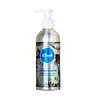What's inside
What's inside
 Key Ingredients
Key Ingredients

 Benefits
Benefits

 Concerns
Concerns

 Ingredients Side-by-side
Ingredients Side-by-side

Water
Skin ConditioningCocamidopropyl Betaine
CleansingDisodium Cocoamphodiacetate
CleansingSodium Laureth Sulfate
CleansingCreatine
Skin ConditioningZinc PCA
HumectantCaffeine
Skin ConditioningHydroxypropyl Oxidized Starch Pg-Trimonium Chloride
HumectantGinkgo Biloba Leaf Extract
Skin ConditioningGlycerin
HumectantLactic Acid
BufferingPiroctone Olamine
PreservativeMenthol
MaskingHexyl Nicotinate
EmollientButylene Glycol
HumectantPropylene Glycol
HumectantPEG-55 Propylene Glycol Oleate
Citric Acid
BufferingParfum
MaskingPhenoxyethanol
PreservativeSodium Benzoate
MaskingWater, Cocamidopropyl Betaine, Disodium Cocoamphodiacetate, Sodium Laureth Sulfate, Creatine, Zinc PCA, Caffeine, Hydroxypropyl Oxidized Starch Pg-Trimonium Chloride, Ginkgo Biloba Leaf Extract, Glycerin, Lactic Acid, Piroctone Olamine, Menthol, Hexyl Nicotinate, Butylene Glycol, Propylene Glycol, PEG-55 Propylene Glycol Oleate, Citric Acid, Parfum, Phenoxyethanol, Sodium Benzoate
Water
Skin ConditioningJasminum Sambac Flower Water
PerfumingGoat Milk
Skin ConditioningCocamidopropyl Betaine
CleansingDisodium Laureth Sulfosuccinate
CleansingDisodium Cocoyl Glutamate
CleansingHydrolyzed Keratin
HumectantPanthenol
Skin ConditioningGlycerin
HumectantSorbitol
HumectantSodium Cocoyl Collagen Amino Acids
Cocoyl Sarcosine
CleansingWheat Germ Acid
CleansingTriticum Vulgare Germ Oil
EmollientPolysorbate 20
EmulsifyingLinoleic Acid
CleansingLinolenic Acid
CleansingTocopherol
AntioxidantSimmondsia Chinensis Seed Oil
EmollientTocopheryl Acetate
AntioxidantPolysorbate 80
EmulsifyingHydrolyzed Glycosaminoglycans
HumectantPhenoxyethanol
PreservativeEthylhexylglycerin
Skin ConditioningGlycol Stearate
EmollientCitrus Medica Peel Oil
Cetyl Alcohol
EmollientPolyquaternium-1
Hydrolyzed Pea Protein
EmollientJasminum Officinale Flower Oil
PerfumingCitric Acid
BufferingGuar Hydroxypropyltrimonium Chloride
Skin ConditioningSodium Gluconate
Skin ConditioningXanthan Gum
EmulsifyingMyroxylon Balsamum Pereirae Balsam Oil
PerfumingWater, Jasminum Sambac Flower Water, Goat Milk, Cocamidopropyl Betaine, Disodium Laureth Sulfosuccinate, Disodium Cocoyl Glutamate, Hydrolyzed Keratin, Panthenol, Glycerin, Sorbitol, Sodium Cocoyl Collagen Amino Acids, Cocoyl Sarcosine, Wheat Germ Acid, Triticum Vulgare Germ Oil, Polysorbate 20, Linoleic Acid, Linolenic Acid, Tocopherol, Simmondsia Chinensis Seed Oil, Tocopheryl Acetate, Polysorbate 80, Hydrolyzed Glycosaminoglycans, Phenoxyethanol, Ethylhexylglycerin, Glycol Stearate, Citrus Medica Peel Oil, Cetyl Alcohol, Polyquaternium-1, Hydrolyzed Pea Protein, Jasminum Officinale Flower Oil, Citric Acid, Guar Hydroxypropyltrimonium Chloride, Sodium Gluconate, Xanthan Gum, Myroxylon Balsamum Pereirae Balsam Oil
Ingredients Explained
These ingredients are found in both products.
Ingredients higher up in an ingredient list are typically present in a larger amount.
Citric Acid is an alpha hydroxy acid (AHA) naturally found in citrus fruits like oranges, lemons, and limes.
Like other AHAs, citric acid can exfoliate skin by breaking down the bonds that hold dead skin cells together. This helps reveal smoother and brighter skin underneath.
However, this exfoliating effect only happens at high concentrations (20%) which can be hard to find in cosmetic products.
Due to this, citric acid is usually included in small amounts as a pH adjuster. This helps keep products slightly more acidic and compatible with skin's natural pH.
In skincare formulas, citric acid can:
While it can provide some skin benefits, research shows lactic acid and glycolic acid are generally more effective and less irritating exfoliants.
Most citric acid used in skincare today is made by fermenting sugars (usually from molasses). This synthetic version is identical to the natural citrus form but easier to stabilize and use in formulations.
Read more about some other popular AHA's here:
Learn more about Citric AcidCocamidopropyl Betaine is a fatty acid created by mixing similar compounds in coconut oil and dimethylaminopropylamine, a compound with two amino groups.
This ingredient is a surfactant and cleanser. It helps gather the dirt, pollutants, and other impurities in your skin to be washed away. It also helps thicken a product and make the texture more creamy.
Being created from coconut oil means Cocamidopropyl Betaine is hydrating for the skin.
While Cocamidopropyl Betaine was believed to be an allergen, a study from 2012 disproved this. It found two compounds in unpure Cocamidopropyl Betaine to be the irritants: aminoamide and 3-dimethylaminopropylamine. High-grade and pure Cocamidopropyl Betaine did not induce allergic reactions during this study.
Learn more about Cocamidopropyl BetaineGlycerin is already naturally found in your skin. It helps moisturize and protect your skin.
A study from 2016 found glycerin to be more effective as a humectant than AHAs and hyaluronic acid.
As a humectant, it helps the skin stay hydrated by pulling moisture to your skin. The low molecular weight of glycerin allows it to pull moisture into the deeper layers of your skin.
Hydrated skin improves your skin barrier; Your skin barrier helps protect against irritants and bacteria.
Glycerin has also been found to have antimicrobial and antiviral properties. Due to these properties, glycerin is often used in wound and burn treatments.
In cosmetics, glycerin is usually derived from plants such as soybean or palm. However, it can also be sourced from animals, such as tallow or animal fat.
This ingredient is organic, colorless, odorless, and non-toxic.
Glycerin is the name for this ingredient in American English. British English uses Glycerol/Glycerine.
Learn more about GlycerinPhenoxyethanol is a preservative that has germicide, antimicrobial, and aromatic properties. Studies show that phenoxyethanol can prevent microbial growth. By itself, it has a scent that is similar to that of a rose.
It's often used in formulations along with Caprylyl Glycol to preserve the shelf life of products.
Water. It's the most common cosmetic ingredient of all. You'll usually see it at the top of ingredient lists, meaning that it makes up the largest part of the product.
So why is it so popular? Water most often acts as a solvent - this means that it helps dissolve other ingredients into the formulation.
You'll also recognize water as that liquid we all need to stay alive. If you see this, drink a glass of water. Stay hydrated!
Learn more about Water